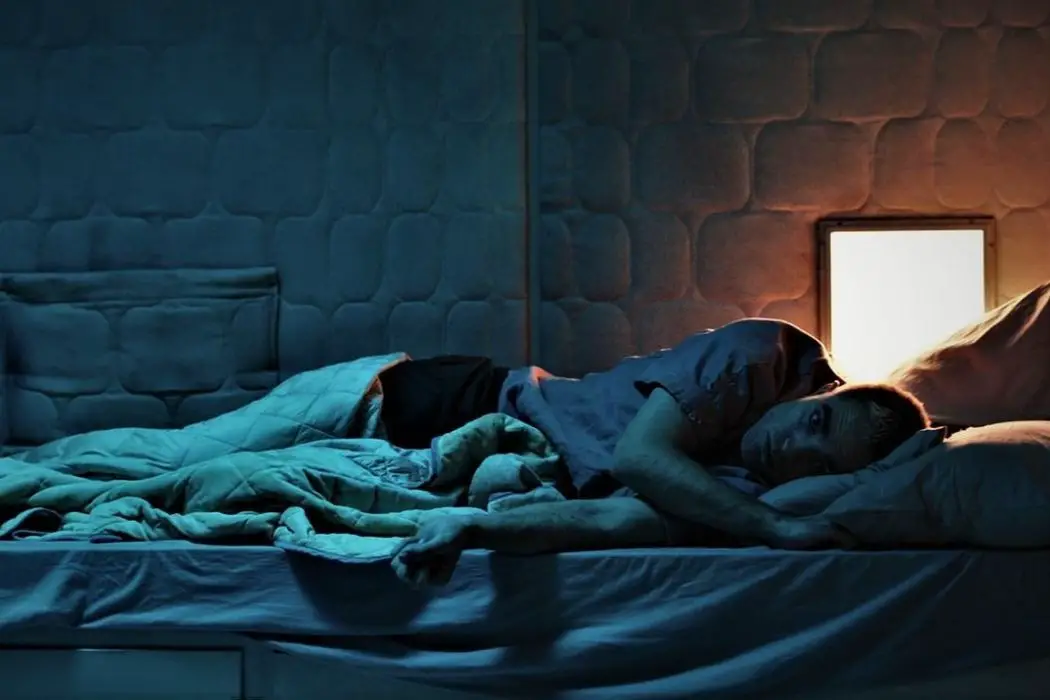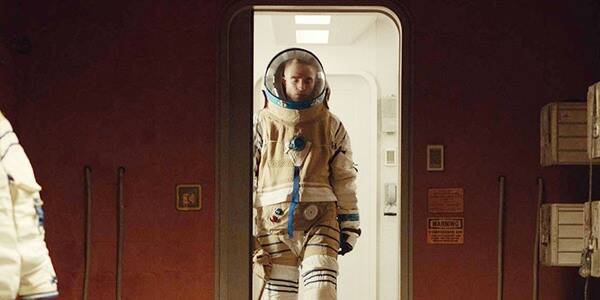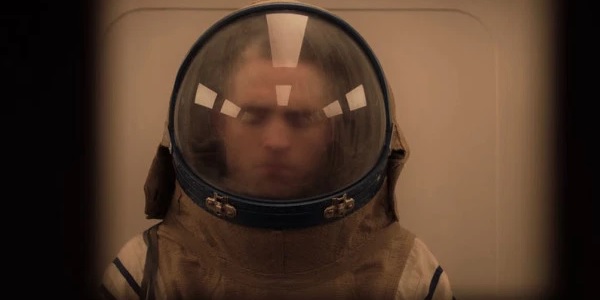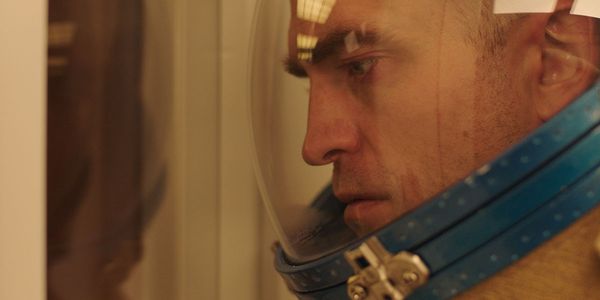Black Holes & The Science Fiction Of Depression In HIGH LIFE

John Stanford Owen received his MFA from Southern Illinois University,…
The onyx-black canvas of space stretches outward, a pathway unfurling in perpetuity. Populated with the watercolor clouds of supernovas and some gaseous planets light enough to float atop water, the cosmos houses all the trappings of scientific curiosity and childlike wonder. But travel a little farther down that interstellar turnpike, and you uncover the aloof and irreversible chaos the universe creates. To get concrete, when a star folds up and fizzles out, a black hole blossoms in its place.
What happens when someone falls in?
Claire Denis learned the precise results that befall a person who wanders too close to that gravitational pull. Theoretical physicist Stephen Hawking christened the process spaghettification, a lethal spectacle unfolding inside a magnetic drag so powerful that not even light escapes its death grip. In short, a person turns to dough, their frame lengthening until the legs and torso pull thin enough to form a noodle shape. At that point, the black hole liquefies the body, shredding it apart nerve by nerve until only a raspberry-hued paste remains. Then, as a final insult, you evaporate.
To make her film High Life, the director needed this information. After all, her movie follows characters headed straight for that exact oblivion. In fact, the spaceship where the bulk of the action unfolds looks like the kind of quick-built, pine box coffin that appears in so many Italian westerns. As the rectangular shuttle hurtles closer to a vacuum that will scramble every passenger to a molecular mush, it makes perfect sense that they arrive at their grim destination in a prepackaged state.
Up there among the stars, it’s an abandon-all-hope kind of place. In other words, if the black hole doesn’t strip the interstellar inmates to particles, the ship’s radiation exposure will whittle them away soon enough. Even that scenario, malevolent as it sounds, discounts the terror added once other humans get involved. But, despite the ghastly subject matter, the film delivers stunning visuals that resonate for weeks after the credits roll.
The picture culminates as a cinematic collage, mixing together the dour tone of Ingmar Bergman, the ambitious scope of Stanley Kubrick, and the total candor of Lynne Ramsay. In this way, Claire Denis directs High Life the way maestros compose symphonies: finding notes that love each other and marrying them together. This angle presents the sharpest of contrasts—half barroom brawl, half string quartet performance—that coalesces to form a cripplingly sad and stunningly beautiful composition.
Deep Space, Deep Sadness
Denis wastes not a second. For its entire duration, High Life dissects the feelings that arise when someone knows doom waits for them inside a hopeless abyss. However, exploration of the mind’s darkest caverns stems not from a dogmatic adherence to existential crises as an arthouse trope. Yes, the film makes for a bummer experience, yet the dreary mood serves as a means to an end.

In a delicious twist of irony, the picture opens with totems that represent life, and not only that which happens in the moment. The film’s initial snapshots characterize the continuation of the human species itself. A garden lush with food and greenery grows beneath a misting trickle that nourishes it. An infant coos and whines for her father’s warm, familiar embrace. Technology has progressed to a point where a baby monitor piped into an astronaut’s helmet seems commonplace if not mundane.
All these images make the case that, in this story, lasting progress cemented itself before we first meet our characters. The audience might ponder the specifics of this particular future—the end of regime-change war or medical advancements that eradicated killer diseases long ago. But, even if that warm, gooey stuff happened down on Earth, it makes no difference in the frigid expanse of space.
Before the title pops on the screen, our protagonist Monte (Robert Pattinson) dresses a number of cadavers in astronaut garb: baggy coveralls, ports for various hoses, and a fishbowl helmet. This ceremony happens before he drops the slack bodies into the quiet grave the galaxy provides. Inside the pressurized suits those fresh corpses wear, the skin and sinew shrinks back, and the skeletons float there, suspended in that black web forever.
The script chronicles the day-in, day-out of a ragtag gaggle of death row inmates. In other prison-centric media, routines include work detail, cell block politicking, and swallowing heroine-filled balloons. In the correctional facilities of deep space, on the other hand, everyday existence becomes much more twisted. In specific terms, the inmates don’t only dispose of cadavers; they also undergo a bevy of human experiments that involve, among other perverse tinkerings, harvesting semen from one person and injecting it inside another.
Dr. Dibs, a reproduction-obsessed inmate and disgraced medical practitioner played by Juliette Binoche, drugs her celestial cellmates and extracts those fluids in preparation for a crude form of artificial insemination. Whether the baby fever stems from a place of misplaced hope or mad scientist experimentation stays up for debate for most of the run time. Once we discover the heinous act that landed Dibs in prison, that answer becomes clear, but in the interim, the film reveals how biological impulses drive her actions.
In the midst of the cold, quasi-clinical nature of her experiments, she aches to experience actual sensuality, a yearning that leads to the film’s most talked-about scene. Upon entering “the f*ckbox,” a somber-lit orgasmatron chamber resembling a claustrophobic exam room, we see the makeshift lover Dibs has made: a metallic vibrator that pops out like a periscope from the seat of a vinyl chair.
Stationed upon such a throne, Dibs writhes and gyrates as Denis’ camera focuses on the mysterious, but clearly self-inflicted scars zigzagging on her stomach. Her hair—fairy tale long, hanging past her lumbar spine—becomes sodden with sweat, the wet tendrils spreading down a glossy, adhesive back. If we knew nothing about the character’s sociopathic personality, the whole production might titillate, but aboard this nihilistic spacecraft, eroticism falls by the wayside.
In spite of the off-the-leash sexuality strewn throughout, High Life’s effect falls nowhere near the aphrodisiac category. That lustful hedonism, no matter how much, occurs in an ongoing effort to deflect ennui and sadness. In the plainest terms, if we all occupy ourselves with whatever feels good, we may clear the cobwebs of depression. The question remains—how long can that diversion method last?
The short answer: distraction numbs the pain only for a brief interval. Denis shows us that thwarting the depression demon hinges less on filling the time and more on finding a reason to continue living. With that in mind, while the film’s thematic concerns focus on the end of existence, much of the plot revolves around birth.
Sensational as these plot points sound, the film remains quiet and meditative for the most part. The narrative spotlight focuses on life and work that goes on despite the fact that every inmate knows the coffin-shaped spaceship heads toward irreversible oblivion. How else should they spend their time? In between recording data reports to send back to Earth and performing routine maintenance on the spaceship hull, Monte cares for his young daughter.
Indeed, a life begins aboard that doomed space vessel, an event that sparks a difficult question regarding reproduction as a moral conundrum. Even if we erase the inevitable black hole demise, these inmates wade through the muck of poisonous relationships. Ritualized sexual assault alongside numerous attempts to murder and maim—these dreadful acts lurk in the background, ready to strike at any moment. And, of course, these events unfold with the brutality you expect. As the baby grows up in this tumult of repeating tragedy, she becomes the poster child for the contracts our circumstances dictate at birth.
In Denis’ work, her characters suffer from a state of dejectedness so extreme that each malicious act and occurrence amounts to a new stone tethered to a person’s limbs. When the weight grows too heavy, they wade into the river and sink. Indeed, with the narrative pointed toward immense darkness, the director creates the ideal vehicle to navigate depression and the accompanying fatigue that leads to giving up. While traveling the bleakest recesses of space and the self, questions shift from “how will we overcome?” to “how long can we last?”
High Life and Solaris: An Affair with Ghosts
The cold, turbulent setting of space provides the perfect backdrop to focus on loss, boredom, and crushing despair. But High Life is not the most famous movie to use the stars as a catalyst for sullen character studies. Directed by renowned Russian filmmaker Andrei Tarkovsky in 1972, Solaris set the highest possible bar for science fiction films that followed it. Both films delve deep into isolation—in both the interstellar and interpersonal senses of the word.
Time will reveal how High Life fares in the film criticism archives, but it remains clear that Tarkovsky’s masterpiece serves as its spiritual predecessor. In one regard, Solaris stands alongside Metropolis and Blade Runner as a supreme achievement under the sci-fi umbrella. At the same time, it joins Au Hasard Balthazar and Fanny and Alexander as a paragon of arthouse cinema royalty. Ergo, it epitomizes a successful marriage between genre convention and artistic accomplishment.

High Life opens with snapshots of nature. And so does Solaris—Tarkovsky ushers us inside his film with an image of babbling water that carries an autumn leaf across a gentle current. Then, layering the narrative with a sliver of magical realism, an aimless horse trots into the frame. These moments reflect hope and introspection, even beauty and imagination, but the bucolic imagery ends up serving as a weapon of self defense against despair.
High Life chronicles years in the life of a man whose pain stems from the lost things that never return. And, once again, so does Solaris. When we meet Kris, our bereaved main character played by Donatas Banionis, he walks through this landscape in a state of brokenness. In his world, profound loss and lingering grief has become a meditative exercise. His wife ended her own life ten years before the film opens, and we can only assume these nature walks happen as a ritual of remembrance.
Aesthetic or narrative, no choice Tarkovsky makes feels arbitrary. The director set his goal to explore what happens when a person loses a loved one to suicide, but must continue the grind of daily life. And Kris continues his responsibilities, working as a psychologist whose latest assignment sees him sent to a space station that hovers over the aquaplanet Solaris.
Other scientists working aboard that satellite experience disturbing hallucinations, and his task involves evaluating the crew’s mental state to determine if the project merits continuation. Of course, it won’t take long for Kris to experience these visions, as well. When the departed lover Hari (Natalya Bondarchuk) returns, she skulks about like a horror film specter, passing through corridors in a fleeting, almost coy manner, as if to tease her full reveal. As she kisses him, he appears forlorn. He knows their reunion is ephemeral.
Hari sticks around for a while, then kills herself again, then resurrects. In Tarkovsky’s world, grief remains a circular event that starts over each day, and he reinforces that notion in the most literal way possible. To end the rinse-and-repeat cycle, Kris places his dead wife’s decoy inside a rocket, and when it blasts off, the boosters light his clothes aflame.
The fantastical imagery proves a fitting choice. If for nothing else, the phantasmagoria helps cushion the blow of a distressing story that comes at you with blunt force. In fact, in terms of visual experimentation, Tarkovsky flips back and forth between color and monochromatics, never fully breaking from the black and white photography that helped make him a cinematic darling.
During certain scenes, a muted blue and white overlay coats the cinematography, wrapping a veil of melancholy over the mise-en-scene. As a storytelling device, the coloration risks gimmickiness, and in the hands of another film maker, the angle might translate as a cheap ploy. Instead, it adds an additional dimension to the Solaris’ experimentation.
However, even when their narratives veers toward surrealism, both Solaris and High Life focus on the most grounded subject: humanity, relationships, love, and the truckload of pain and suffering that goes with all that. As we follow our protagonists, we look inside the vault of their mind, witnessing how their memories construct their lives. These snippets project like home movies for the audience. We see a child build a campfire in the snow in one film. We see the bond growing between a boy and his dog in another.
These bittersweet postcards remind the characters that sunnier circumstances existed at one point, and after these moments fizzled out, they replay the kinder times for comfort. All of it has vanished, yes, yet the experience lingers for years. While Monte and Kris live and work aboard different space crafts, even though one works as a doctor and the other a prison inmate, both characters remain in love with a ghost. Their happiness exists somewhere in another time, and they remember it, though it no longer belongs to them.
Final Thoughts: How High Life Reinforces the Definition of Science Fiction
To pigeonhole a definition for science fiction leads to cartoonish pictures popping into the mind. The process conjures images of flying saucers fashioned from spinning hubcaps that hang from strings or rockets that crash inside the Man in the Moon’s eye. However, in terms of whittling down genre conventions, psychosocial elements bear more weight than visual motifs. And High Life epitomizes that notion.
The chief authority on the genre, sci-fi legend Ray Bradbury, once explained it this way: “I define science fiction as the art of the possible. Fantasy is the art of the impossible. Science fiction, again, is the history of ideas, and they’re always ideas that work themselves out and become real and happen in the world.”

Therein lies the stark truth: these events manifest at some point. When Jules Verne wrote From Earth to the Moon in 1902, he predicted Neil Armstrong and Buzz Aldrin bouncing across that dusty surface, which happened 67 years after the book’s publication. But the predictions art makes often stray from forecasting human progress and achievement. In other words, things get darker. To get specific, while it never quite happens on the government-sanctioned scale described in Bradbury’s Fahrenheit 451, banning (and outright burning) books still occurs.
Likewise, High Life refuses to exempt itself from sci-fi’s prophetic nature, which means a pressing question hangs in the air. What catastrophic future does the film predict? As chatter about leaving this warming planet and its threadbare atmosphere buzzes on, Denis’ fiction proves terrifyingly plausible. After all, it’s not unlikely that, before the world’s wealthiest station themselves upon interstellar safe havens, prisoners would bear the responsibility of safety testing.
What’s more, what happens to those without resources to evacuate a dying world?
The movie presents a challenge, for sure, but not in light of the highfalutin reputation it gained. The struggle stems from the feature’s candor about humans and their penchant for engineering havoc. As a film about chasing the unattainable (in this case, a long, happy life), High Life shows us the hellish reality we head toward now. As a result, Claire Denis solidifies her film’s classification as both science fiction and a time-sensitive cautionary tale. In giving us this dour forewarning, she shows us why she hopes to be wrong. She tells us we can turn back from the black hole we made.
What did you think of High Life? How does it compare to other science fiction films? Let us know in the comments!
Does content like this matter to you?
Become a Member and support film journalism. Unlock access to all of Film Inquiry`s great articles. Join a community of like-minded readers who are passionate about cinema - get access to our private members Network, give back to independent filmmakers, and more.
John Stanford Owen received his MFA from Southern Illinois University, where he also taught English courses. When JSO is not penning reviews and essays on cinema, he's reading and writing poetry, walking with his dog, or dancing to Radiohead.













